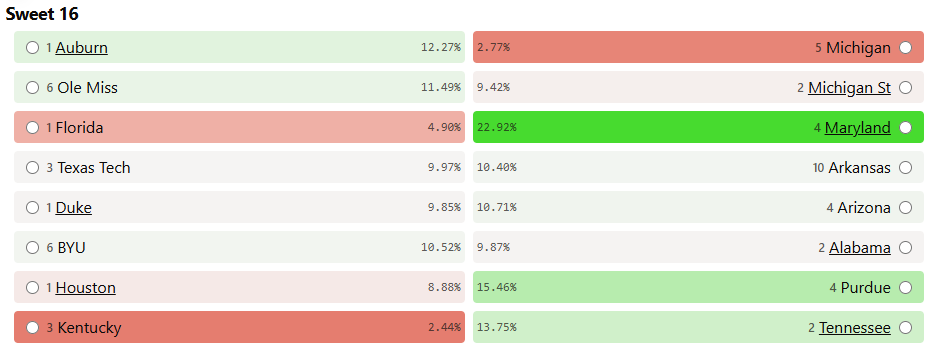ESPN's Bracket Forecast is Lying to You
And Why My Website is Better
Four years ago, I was in a ten-person March Madness pool, and wanted to know my likelihood of winning it. It was the Monday after the first weekend (just like today), so there were sixteen teams remaining, which meant that there were only 32,768 possible outcomes remaining, and it occurred to me that it wouldn’t be too difficult to write a script in R that calculated the probability of each of these outcomes, the winning player from our pool for each outcome, and from that, each player’s total winning probability. So I did this, emailed my ten friends a csv file with the results, and then added a few sentences on at the end about how the upcoming games affected our respective chances.
In the intervening Marches Madness, I’ve become progressively more insane about this project. The few sentences turned into entire narrative paragraphs chronicling each bracket’s journey, with lots of descriptive adjectives and metaphors. For no reason at all, I started referring to some brackets as baboons. I created created win probability charts for each game, and graphical representations of each person’s most likely path to victory. If you wanted to spend a lot of time thinking about your chance of winning the bracket pool, I was your absolute guy. If you were worried about your email inbox becoming too cluttered, I was a menace.1
Last year, I noticed something distressing: ESPN had started copying my schtick. From the Round of 16 on, the “Group” view in the tournament featured a tab labelled “Forecast,” and when selected, it purported to show each person’s win probability! It even had a little interactive graphic where you could see you probability conditional on a specific team winning the championship. It didn’t have game-by-game information (or narrative, zoological color) like my emails did, but it had me beat in terms of convenience (it was right there in the app), graphic design (my charts were cool but they looked like a middle school art project compared to these), and most importantly, scale. Everyone who had made a bracket now had up to date probability calculations. Being my friend was no longer a prerequisite. After four years of hand-spinning my artisanal bracket projections, I’d been rendered obsolete by Big Bracket. I was devastated.
But then I noticed something: their predictions were absolute garbage. The consensus of the betting markets and the top models was that Houston probably had about the third or fourth-best chance of winning the tournament at that time, a clear tier below heavyweights Purdue and eventual champion UConn. ESPN’s Basketball Power Index (BPI), which powers their projections, not only had Houston first, but saw them as unprecedented juggernauts, with a 37% of winning the tournament in the Sweet 16. Probabilistic forecasts are notoriously hard to evaluate in real time. “Hey, I said there was a chance!” the forecaster can always say. But this forecast was clearly wrong, it was wildly out of step with all other available information, and in fact, Houston got upset in their very next game. UConn won, as everyone else said they probably would.
Nevertheless, I worried that they’d come out with a more accurate forecast, and that I could only stave off obsolesce for so long with my artisanal handspun approach. In order to stay relevant in the bracket forecasting game, I built a website with a friend that would streamline the process, sync to any group on ESPN without any manual data entry, and give forecasts from the tip-off of the first game, rather than making you wait for the Round of 16. Only by innovating, I thought, could I remain relevant, with a competitive advantage against Big Bracket.
Nope. Turns out I didn’t need to do any of that. Their forecast remains just as bad and wrong as it was last year. Take a look:
Once again, BPI is wildly overconfident in the ability of the Houston Cougars, giving them a 22% win probability when sportsbooks are not willing to go above 15%. Even more egregiously, BPI believes that the 2025 SEC Champion Florida Gators (22.2% according to sportsbooks) are trash, with less than a 10% win probability.
My website does not go by sportsbook odds either. I use Nate Silver’s model, which is well-calibrated historically, and while it also diverges from the markets here and there by a percentage point or two, it’s well within the consensus of reasonable forecasts of this tournament. ESPN’s BPI is not reasonable, and must be ignored at all costs.
And I remain a menace!! Look at me now, emailing you all!!! Mwahahahah 😈


